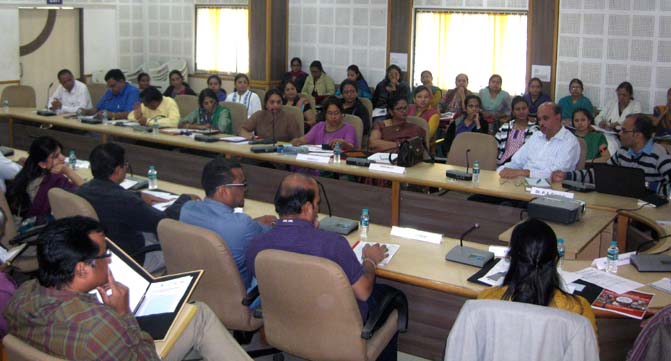Vibrant Gujarat - Evaluating Ahmedabad's Heat Action Plan
Vibrant Gujarat - Evaluating Ahmedabad's Heat Action Plan
Since 2012, CDKN has been working with partners in India to address heat-health vulnerability in rapidly urbanising regions of Western India. Nehmat Kaur from the Natural Resources Defense Council (NRDC) writes about the project and ongoing efforts to deepen and expanding heat health action in India.
Located in the hot and urbanising northwestern corner of India, the state of Gujarat has been abuzz with activities around the Vibrant Gujarat 2015 Summit that was held in January 2015. Vibrant Gujarat is an initiative created by Prime Minister Narendra Modi when he was the state’s Chief Minister to showcase the state nationally and internationally as a place for progress, development and business. This year’s summit was attended by international companies and dignitaries, including (among others) Prime Minister Modi, UN Secretary-General Ban Ki-Moon, U.S. Secretary of State John Kerry, and Dutch Prime Minister Mark Butte.
One key focus and goal of the Vibrant Gujarat Summits is encouraging attendees to enter into knowledge and strategic partnerships (called “Memoranda of Understanding” or “MOUs”). NRDC and our partners, the Public Health Foundation of India (PHFI) and the Indian Institute of Public Health (IIPH), signed an MOU with the state of Gujarat at a past Summit, leading to the development and implementation of the country’s first Heat Action Plan in the state’s largest city, Ahmedabad, in 2013.
This Heat Action Plan—an early warning system and heat preparedness plan aimed at saving lives—is a landmark project for the city’s government, the Ahmedabad Municipal Corporation (AMC). As the region’s annual heat season brings scorching temperatures from April to June, the Ahmedabad Climate Heat Action Group—a coalition of scientific and policy experts including the AMC, NRDC, PHFI, IIPH and others—releases the city’s Heat Action Plan with stakeholder feedback from the previous heat season. After the heat season, the coalition holds a follow-up stakeholder evaluation workshop to bring together all government and non-governmental agencies and groups that have worked together to safeguard Ahmedabad’s most vulnerable communities from the health effects of extreme heat (for more information about the creation and implementation of the pilot Heat Action Plan, please see here and here).
The evaluation workshop for 2014 was held in December in Ahmedabad under the leadership of the AMC. Led by NRDC and IIPH, more than 50 participants from various AMC departments, the local emergency medical response services (known as “108 GVK-EMRI”), and local health professionals came together for a half-day workshop to discuss the successes and lessons learned from the 2014 Heat Action Plan and how to enhance the 2015 Heat Action Plan.
[caption id="attachment_48298" align="aligncenter" width="671"] AMC Heat Action Plan Evaluation Workshop in Ahmedabad, December 11, 2014. Photo: NRDC[/caption]
AMC Heat Action Plan Evaluation Workshop in Ahmedabad, December 11, 2014. Photo: NRDC[/caption]
Each participant was fully engaged and provided their input on concrete suggestions for the 2015 Heat Action Plan, leading to many valuable ideas. Key takeaways from the workshop included:
- To increase community awareness, stakeholders suggested conducting more focused outreach in identified high-risk communities across the city. Because children and slum communities are two of the most vulnerable groups to heat-related health complications in Ahmedabad, a valuable suggestion was to focus on outreach to primary schools—including efforts such as “teaching the teachers” (to disseminate tips to their students on how to protect oneself during a heat wave) and conducting tree planting drives (to increase areas of shaded respite). Additionally, because radio is a highly utilized and accessible news source among the city’s slum populations, radio broadcasts are an effective communication tool to disseminate heat protection tips and high temperature warnings to reach the target communities.
- To improve interagency communication and the medical response during the heat season, stakeholders suggested developing concrete distribution plans for supplies such as ice packs and drinking water resources. Hospitals could also appoint a nodal officer to report on heat-related cases during the three months of extreme heat in order to keep a closer tab on heat-related sickness in the city.
As these proposed interventions make clear, the workshop helped develop concrete strategies and programs to enhance the 2015 Heat Action Plan ahead of Ahmedabad’s next heat season.
Looking ahead to 2015, NRDC, AMC, IIPH and the rest of the Ahmedabad Climate Heat Action Group is now planning a two day summit in Gujarat in the month of April, to launch the Ahmedabad Heat Action Plan for 2015. The summit will also bring together other cities in India to scale the action on heat as well as disaster management stakeholders in India to improve resilience at the national level, to protect India’s most vulnerable populations in the face of climate change fuelling more extreme temperatures.
